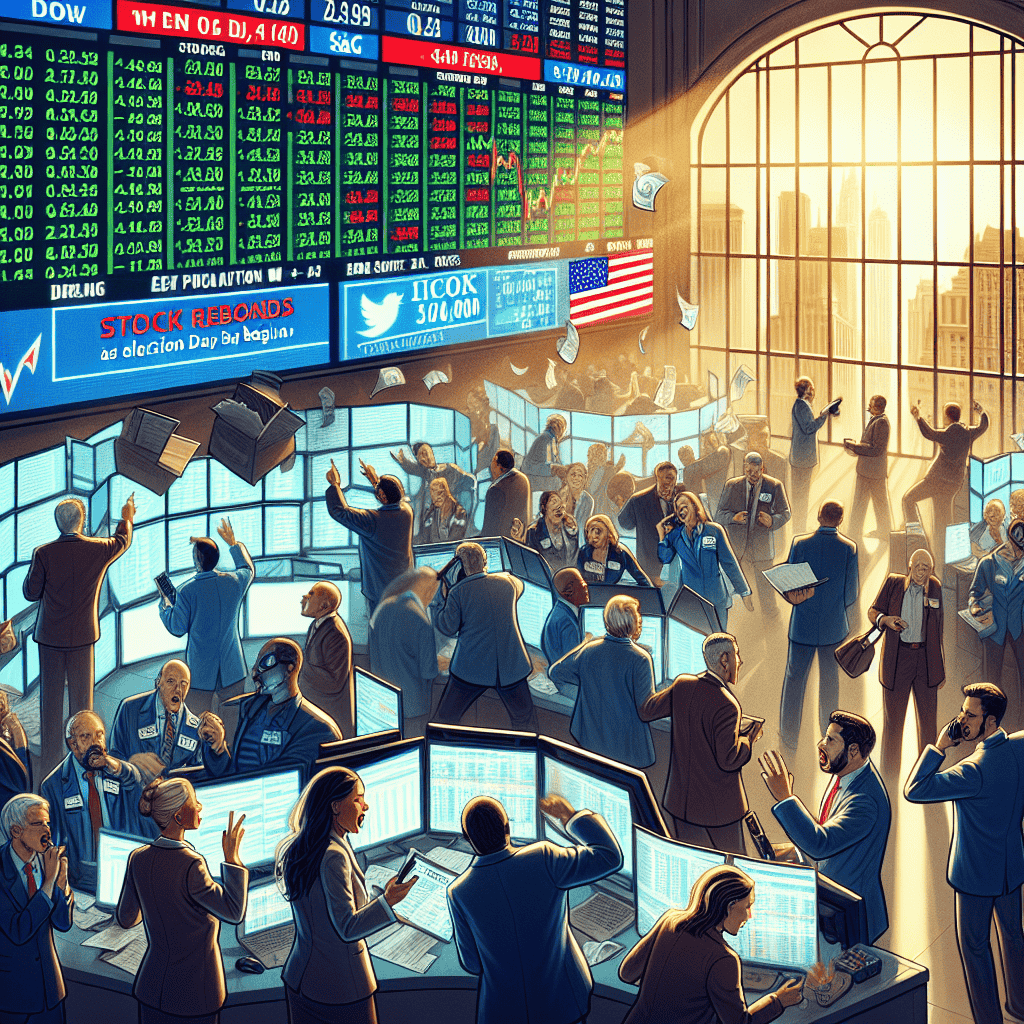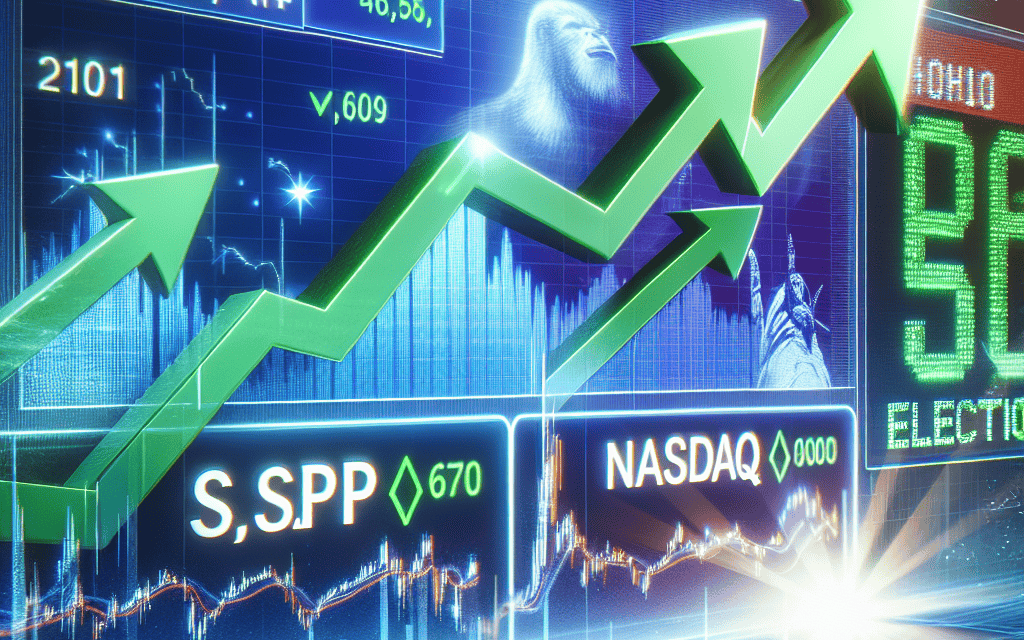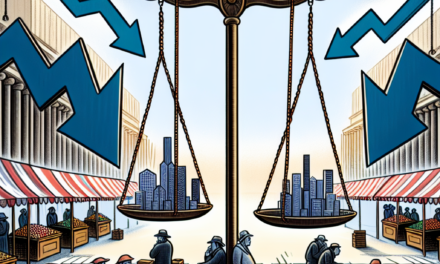“Election Day Surge: Markets Rally as Voters Head to the Polls!”
Introduction
As Election Day unfolds, the stock market is experiencing a notable rebound, with major indices such as the Dow Jones Industrial Average, the S&P 500, and the Nasdaq Composite all showing significant upward momentum. This resurgence comes amid heightened investor optimism and anticipation surrounding the electoral outcomes and their potential impact on economic policies. Historically, markets have often reacted to the political climate, and this election cycle is no exception. The current rally reflects a complex interplay of factors, including investor sentiment, economic forecasts, and the perceived stability that a clear electoral result might bring. As the day progresses, market participants are closely monitoring developments, with the hope that the election will provide clarity and direction for future economic growth and policy-making.
Impact Of Election Day On Stock Market Trends
As Election Day commences, the stock market is experiencing a notable rebound, with major indices such as the Dow Jones Industrial Average, the S&P 500, and the Nasdaq Composite all showing upward momentum. This resurgence in the stock market is not merely a reflection of investor optimism but also a testament to the intricate relationship between political events and financial markets. Historically, election periods have been characterized by heightened volatility, as investors grapple with the potential implications of new policies and leadership changes. However, as the voting process begins, a sense of clarity often emerges, leading to a stabilization or even an upswing in market performance.
The current rise in the stock market can be attributed to several factors, one of which is the anticipation of policy continuity or change, depending on the election’s outcome. Investors are keenly aware that different administrations prioritize varying economic policies, which can significantly impact sectors such as healthcare, energy, and technology. For instance, a government favoring renewable energy initiatives might boost stocks in that sector, while another focusing on deregulation could benefit traditional energy companies. As such, the market’s current upward trend may reflect investor speculation on which sectors are likely to thrive under the new administration.
Moreover, the stock market’s rebound is also influenced by broader economic indicators that have shown resilience in the face of political uncertainty. Recent data on employment, consumer spending, and corporate earnings have painted a picture of an economy that, while not without its challenges, continues to demonstrate underlying strength. This economic backdrop provides a foundation for investor confidence, as it suggests that the market is capable of weathering potential policy shifts that may arise post-election.
In addition to domestic factors, global economic conditions also play a crucial role in shaping stock market trends during election periods. International investors closely monitor U.S. elections, given the country’s significant influence on global markets. The prospect of stable U.S. leadership can reassure foreign investors, leading to increased capital inflows and further bolstering the stock market. Conversely, uncertainty or perceived instability can result in capital flight, underscoring the importance of a smooth electoral process.
Furthermore, it is essential to consider the psychological aspect of market behavior during elections. Investor sentiment often drives short-term market movements, and the current rebound may be partially attributed to a collective sigh of relief as the election process unfolds without major disruptions. This sentiment-driven rally can create a self-reinforcing cycle, where rising stock prices boost investor confidence, leading to further market gains.
While the stock market’s current trajectory is encouraging, it is crucial for investors to remain vigilant. The outcome of the election will undoubtedly have long-term implications for fiscal and monetary policy, trade relations, and regulatory frameworks. As such, market participants should be prepared for potential fluctuations as the new administration’s policies begin to take shape.
In conclusion, the stock market’s rebound as Election Day begins is a multifaceted phenomenon driven by a combination of policy anticipation, economic resilience, global factors, and investor sentiment. As the election unfolds, the interplay between these elements will continue to shape market trends, offering both opportunities and challenges for investors navigating this dynamic landscape.
Historical Analysis Of Stock Market Rebounds During Elections
As Election Day unfolds, the stock market often becomes a focal point for investors and analysts alike, eager to discern how political shifts might influence economic landscapes. Historically, the stock market has exhibited a tendency to rebound during election periods, a phenomenon that can be attributed to a variety of factors. This year, as the Dow Jones Industrial Average, the S&P 500, and the Nasdaq Composite all show signs of upward momentum, it is worthwhile to explore the historical context of such rebounds and the underlying reasons that drive these market behaviors.
To begin with, the stock market’s performance during election years is often influenced by the anticipation of policy changes and economic strategies that accompany a new administration. Investors typically seek stability and predictability, and the conclusion of an election cycle can provide a clearer picture of future economic policies. This clarity often results in increased investor confidence, which in turn can lead to a market rebound. Historically, the market has shown a pattern of volatility leading up to an election, followed by a period of recovery as uncertainties diminish.
Moreover, the stock market’s response to elections is not solely dependent on the outcome but also on the perceived economic competence of the candidates. Investors tend to favor candidates whose policies are expected to foster economic growth, reduce regulatory burdens, and promote business-friendly environments. Consequently, when such candidates gain traction in the polls, the market often reacts positively, anticipating favorable conditions for corporate profitability and economic expansion.
In addition to these factors, it is important to consider the role of market psychology during election periods. The stock market is not only a reflection of economic fundamentals but also a barometer of investor sentiment. During elections, emotions can run high, and market participants may react to news and developments with heightened sensitivity. This can lead to short-term fluctuations; however, as the election concludes and emotions settle, the market often stabilizes and rebounds as rational analysis prevails over speculative behavior.
Furthermore, historical data suggests that the stock market tends to perform well in the months following an election, regardless of which party assumes power. This trend can be attributed to the market’s ability to adapt to new political realities and the resilience of the underlying economy. For instance, the post-election period often sees a renewed focus on fiscal policies, infrastructure spending, and other initiatives aimed at stimulating economic growth. These factors can contribute to a positive market trajectory as investors adjust their portfolios to align with the anticipated policy landscape.
In conclusion, the stock market’s rebound as Election Day begins is not an isolated event but rather part of a broader historical pattern. The interplay of investor confidence, policy expectations, and market psychology all contribute to this phenomenon. As the Dow, S&P 500, and Nasdaq continue their upward trend, it is essential for investors to remain informed and consider the historical context of market behavior during elections. By doing so, they can better navigate the complexities of the market and make informed decisions that align with their financial goals. As history has shown, while elections may introduce temporary volatility, they also present opportunities for growth and recovery in the stock market.
Factors Driving The Dow, S&P 500, And Nasdaq Upward
As Election Day unfolds, the stock market is experiencing a notable rebound, with the Dow Jones Industrial Average, the S&P 500, and the Nasdaq Composite all showing upward momentum. This positive shift in the market can be attributed to a confluence of factors that are instilling confidence among investors. Understanding these driving forces provides insight into the current market dynamics and the potential implications for future economic trends.
One of the primary factors contributing to the market’s upward trajectory is the anticipation of political stability following the election. Historically, markets tend to react favorably to the resolution of electoral uncertainty, as investors prefer a clear political direction that allows for more predictable economic policies. As Election Day progresses, the prospect of a definitive outcome is reducing the ambiguity that has weighed on market sentiment in recent weeks. This reduction in uncertainty is encouraging investors to re-enter the market, driving up stock prices across major indices.
In addition to political factors, economic indicators are playing a crucial role in bolstering market confidence. Recent data releases have shown signs of resilience in key sectors of the economy, including manufacturing and consumer spending. These indicators suggest that the economic recovery, although uneven, is gaining traction. The strength in consumer spending, in particular, is a positive signal, as it accounts for a significant portion of economic activity. As consumers continue to spend, businesses are likely to see increased revenues, which in turn supports higher stock valuations.
Moreover, corporate earnings reports have been largely positive, exceeding analysts’ expectations in many cases. Companies across various sectors have demonstrated their ability to adapt to challenging conditions, implementing cost-cutting measures and leveraging technology to maintain profitability. This adaptability has reassured investors about the long-term viability of these companies, contributing to the upward movement in stock prices. As earnings season progresses, continued positive results could further reinforce investor confidence.
Another factor influencing the market’s rise is the monetary policy stance of the Federal Reserve. The central bank has maintained a dovish approach, signaling its commitment to keeping interest rates low for an extended period. This accommodative monetary policy is designed to support economic growth by making borrowing more affordable for businesses and consumers. Low interest rates also make equities more attractive compared to fixed-income investments, prompting investors to allocate more capital to the stock market. The Fed’s stance provides a supportive backdrop for the market, encouraging risk-taking and investment in equities.
Furthermore, the global economic environment is contributing to the positive sentiment in U.S. markets. As major economies around the world continue to recover from the disruptions caused by the pandemic, international trade and investment are picking up. This global recovery is beneficial for U.S. companies with significant overseas operations, as it expands their market opportunities and potential for growth. The interconnectedness of global markets means that improvements abroad can have a favorable impact on domestic stock indices.
In conclusion, the rebound in the Dow, S&P 500, and Nasdaq as Election Day begins is driven by a combination of political, economic, and monetary factors. The resolution of electoral uncertainty, positive economic indicators, strong corporate earnings, accommodative monetary policy, and a recovering global economy are all contributing to the current upward trend in the stock market. As these factors continue to evolve, they will play a crucial role in shaping the future trajectory of the market, offering both opportunities and challenges for investors.
Investor Sentiment And Market Volatility On Election Day

As Election Day unfolds, investor sentiment is closely intertwined with market volatility, creating a dynamic environment for the stock market. Today, the Dow Jones Industrial Average, the S&P 500, and the Nasdaq Composite are all experiencing upward momentum, reflecting a renewed sense of optimism among investors. This positive trend is noteworthy, especially considering the market’s recent fluctuations driven by economic uncertainties and geopolitical tensions. The anticipation surrounding the election results has undoubtedly played a significant role in shaping investor behavior, as market participants attempt to gauge the potential impact of political outcomes on economic policies and corporate performance.
In the lead-up to Election Day, market volatility has been a defining characteristic, with investors reacting to a myriad of factors, including inflation concerns, interest rate adjustments, and global supply chain disruptions. However, as voting commences, there appears to be a shift in sentiment, with investors displaying a more bullish outlook. This change can be attributed to several factors, including the belief that a clear election outcome could provide much-needed clarity and stability, thereby reducing uncertainty in the market. Moreover, historical trends suggest that markets often experience a rebound following elections, as investors adjust their portfolios in response to the new political landscape.
The rise in the Dow, S&P 500, and Nasdaq is also indicative of investor confidence in the resilience of the U.S. economy. Despite the challenges posed by the pandemic and other external pressures, the underlying fundamentals of the economy remain robust. Corporate earnings have generally exceeded expectations, and consumer spending continues to be a driving force behind economic growth. These factors contribute to a more favorable investment climate, encouraging market participants to re-engage with equities.
Furthermore, the current market rally can be seen as a reflection of investor expectations regarding future fiscal and monetary policies. Depending on the election outcome, there may be shifts in government spending priorities, tax policies, and regulatory frameworks, all of which have significant implications for various sectors. Investors are keenly aware of these potential changes and are positioning themselves accordingly, seeking opportunities in sectors that stand to benefit from the anticipated policy directions.
It is also important to consider the role of technology and innovation in shaping market dynamics on Election Day. The Nasdaq, in particular, has been buoyed by strong performances from tech giants, which continue to drive growth and capture investor interest. The ongoing digital transformation across industries underscores the importance of technology as a key driver of economic progress, further bolstering investor confidence in the sector.
As the day progresses, market participants will continue to monitor election developments closely, with the understanding that the final results could have far-reaching implications for both domestic and global markets. While the current upward trend is encouraging, it is essential for investors to remain vigilant and adaptable, as market conditions can change rapidly in response to new information.
In conclusion, the stock market’s rebound on Election Day highlights the complex interplay between investor sentiment and market volatility. As the Dow, S&P 500, and Nasdaq rise, it is evident that investors are cautiously optimistic about the future, driven by a combination of economic resilience, policy expectations, and technological advancements. As always, maintaining a balanced perspective and staying informed will be crucial for navigating the evolving market landscape.
Comparing Current Stock Market Rebounds To Past Election Cycles
As Election Day unfolds, the stock market is experiencing a notable rebound, with major indices such as the Dow Jones Industrial Average, the S&P 500, and the Nasdaq Composite all showing upward momentum. This resurgence in the market is drawing comparisons to past election cycles, where similar patterns of volatility and recovery have been observed. Understanding these historical trends provides valuable insights into the current market dynamics and investor behavior.
Historically, election cycles have been periods of uncertainty for the stock market, as investors grapple with the potential implications of new policies and leadership changes. This uncertainty often leads to increased volatility, with markets experiencing fluctuations as investors react to polling data, debates, and other election-related events. However, it is not uncommon for markets to rebound as Election Day approaches and the outcome becomes clearer. This pattern is evident in the current market behavior, where investors seem to be regaining confidence, driving indices higher.
Comparing the current rebound to past election cycles, it is important to note that the stock market’s performance is influenced by a myriad of factors, including economic conditions, geopolitical events, and investor sentiment. For instance, during the 2008 election cycle, the market was heavily impacted by the global financial crisis, leading to significant declines. However, as the election concluded and a new administration took office, the market began to recover, reflecting renewed investor confidence in the economic recovery efforts.
Similarly, the 2016 election cycle saw heightened volatility, with markets reacting sharply to unexpected political developments. In the weeks leading up to the election, the stock market experienced fluctuations as investors weighed the potential impact of different policy proposals. Yet, following the election, the market rebounded, driven by optimism about economic growth and regulatory changes. This pattern of initial uncertainty followed by recovery underscores the resilience of the stock market in adapting to new political landscapes.
In the current election cycle, the stock market’s rebound can be attributed to several factors. Firstly, investors are closely monitoring economic indicators, such as employment data and corporate earnings, which have shown signs of improvement. This positive economic outlook is bolstering investor confidence, contributing to the upward momentum in the market. Additionally, the prospect of fiscal stimulus measures and infrastructure spending is fueling optimism about future economic growth, further supporting the market’s recovery.
Moreover, advancements in technology and innovation are playing a crucial role in shaping investor sentiment. The Nasdaq Composite, which is heavily weighted towards technology stocks, has been a key driver of the current market rebound. As companies continue to adapt to the digital economy, investors are increasingly optimistic about the growth potential of technology-driven sectors, contributing to the overall positive market sentiment.
In conclusion, the current stock market rebound as Election Day begins is reminiscent of past election cycles, where initial uncertainty gives way to recovery as investors gain clarity on the political and economic landscape. While each election cycle presents unique challenges and opportunities, the underlying resilience of the stock market remains a constant. By examining historical trends and understanding the factors driving current market dynamics, investors can better navigate the complexities of election-related market movements and make informed decisions. As the election unfolds, continued monitoring of economic indicators and policy developments will be crucial in assessing the market’s trajectory in the coming months.
Key Sectors Benefiting From Election Day Market Movements
As Election Day unfolds, the stock market is experiencing a notable rebound, with major indices such as the Dow Jones Industrial Average, the S&P 500, and the Nasdaq Composite all showing positive momentum. This upward trend is not only a reflection of investor optimism but also highlights the key sectors that are benefiting from the current market movements. Understanding these sectors provides valuable insights into the dynamics at play and the potential implications for future market behavior.
To begin with, the technology sector is witnessing a significant boost, driven by the anticipation of favorable policies that could emerge post-election. Investors are particularly optimistic about the potential for increased government spending on digital infrastructure and innovation, which could lead to enhanced growth opportunities for tech companies. As a result, major tech stocks are seeing a surge in demand, contributing to the overall rise in the Nasdaq Composite. This sector’s performance underscores the critical role technology continues to play in shaping the modern economy and its resilience in the face of political uncertainties.
In addition to technology, the healthcare sector is also experiencing a positive impact from the election day market movements. The sector’s performance is buoyed by expectations of policy stability and potential reforms that could enhance healthcare access and affordability. Investors are closely monitoring the election outcomes for any indications of changes in healthcare regulations, which could influence the profitability and operational strategies of healthcare companies. Consequently, healthcare stocks are attracting increased investor interest, reflecting the sector’s importance in both economic and social contexts.
Moreover, the financial sector is benefiting from the current market rebound, as investors anticipate a more favorable regulatory environment that could emerge following the elections. Financial institutions, including banks and investment firms, are poised to capitalize on potential policy shifts that may encourage lending and investment activities. The prospect of regulatory easing is particularly appealing to investors, as it could lead to increased profitability for financial entities. This optimism is reflected in the rising stock prices of major financial companies, contributing to the overall positive performance of the Dow Jones Industrial Average.
Furthermore, the energy sector is also gaining traction amid the election day market movements. With the potential for new energy policies that could support both traditional and renewable energy sources, investors are showing renewed interest in energy stocks. The sector’s performance is further bolstered by the global demand for energy, which remains robust despite geopolitical uncertainties. As a result, energy companies are experiencing a surge in stock prices, highlighting the sector’s critical role in the global economy and its potential for growth in a post-election landscape.
In conclusion, the stock market’s rebound on Election Day is a multifaceted phenomenon, with key sectors such as technology, healthcare, financials, and energy leading the charge. These sectors are benefiting from investor optimism and the anticipation of favorable policy outcomes that could emerge from the elections. As the day progresses, market participants will continue to closely monitor election results and their potential implications for these sectors. The current market movements not only reflect the immediate impact of Election Day but also set the stage for future trends and opportunities in the stock market.
Expert Predictions On Post-Election Stock Market Performance
As Election Day unfolds, the stock market is experiencing a notable rebound, with major indices such as the Dow Jones Industrial Average, the S&P 500, and the Nasdaq Composite all showing signs of recovery. This upward trend has captured the attention of investors and analysts alike, prompting a wave of expert predictions regarding the post-election performance of the stock market. Historically, the stock market has demonstrated a tendency to react to the political climate, with elections often serving as a catalyst for market volatility. However, the current rebound suggests a degree of optimism among investors, who are closely monitoring the potential outcomes and their implications for economic policy.
Experts are weighing in on the factors that could influence the market’s trajectory in the aftermath of the election. One key consideration is the anticipated policy direction of the incoming administration, which could have significant ramifications for various sectors. For instance, a government that prioritizes infrastructure spending might boost construction and manufacturing stocks, while a focus on healthcare reform could impact pharmaceutical and insurance companies. Additionally, tax policies and regulatory changes are likely to play a crucial role in shaping investor sentiment and market dynamics.
Moreover, the global economic environment remains a critical factor in determining the stock market’s future performance. With ongoing concerns about inflation, supply chain disruptions, and geopolitical tensions, investors are keenly aware of the interconnectedness of global markets. The election’s outcome could influence international relations and trade policies, thereby affecting multinational corporations and their stock valuations. As such, experts are advising investors to remain vigilant and consider the broader economic context when making investment decisions.
Another aspect that experts are highlighting is the potential for increased market volatility in the short term. Elections often bring uncertainty, and the period immediately following can be marked by fluctuations as investors digest the results and assess their implications. However, many analysts believe that the market’s long-term trajectory will ultimately be determined by fundamental economic indicators such as corporate earnings, employment rates, and GDP growth. Therefore, while short-term volatility is expected, the underlying strength of the economy will likely guide the market’s direction in the months and years to come.
In light of these considerations, experts are offering varied predictions on the post-election stock market performance. Some are optimistic, suggesting that a clear election outcome could provide the stability needed for sustained market growth. Others are more cautious, warning that unresolved political issues or contested results could prolong uncertainty and hinder market progress. Regardless of the differing viewpoints, there is a consensus that diversification remains a prudent strategy for investors seeking to navigate the post-election landscape.
In conclusion, as the stock market rebounds on Election Day, experts are closely analyzing the potential impacts of the election on future market performance. While the immediate reaction has been positive, the long-term outlook will depend on a multitude of factors, including policy decisions, global economic conditions, and fundamental economic indicators. Investors are encouraged to stay informed and consider expert insights as they make strategic decisions in this dynamic environment. As the election results unfold, the stock market will undoubtedly continue to be a focal point for both investors and analysts, reflecting the complex interplay between politics and economics.
Q&A
1. **What is a stock market rebound?**
A stock market rebound refers to a recovery in stock prices after a period of decline or volatility.
2. **How do elections impact the stock market?**
Elections can create uncertainty, leading to volatility, but they can also lead to market rebounds as investors anticipate policy changes.
3. **What are the Dow, S&P 500, and Nasdaq?**
They are major stock market indices in the U.S. that track the performance of selected stocks: the Dow Jones Industrial Average, the S&P 500, and the Nasdaq Composite.
4. **Why might the stock market rise on Election Day?**
The market might rise due to investor optimism about potential policy outcomes or relief from uncertainty as election results become clearer.
5. **What factors contribute to a stock market rebound?**
Factors include positive economic data, investor sentiment, policy announcements, and resolution of uncertainties.
6. **How can investors benefit from a stock market rebound?**
Investors can benefit by seeing an increase in the value of their investments and potentially realizing gains if they sell at higher prices.
7. **What risks are associated with stock market rebounds?**
Risks include potential volatility, the possibility of a short-lived rebound, and external factors that could reverse gains.
Conclusion
As Election Day begins, the stock market is experiencing a notable rebound, with key indices such as the Dow Jones Industrial Average, S&P 500, and Nasdaq Composite all showing upward momentum. This positive movement suggests increased investor confidence, possibly driven by expectations of political stability or favorable economic policies post-election. Historically, markets often react to the perceived certainty that elections bring, and this rebound could indicate optimism about future economic conditions. However, it’s important to remain cautious, as market volatility can persist until election outcomes are fully realized and any new policies are implemented.





